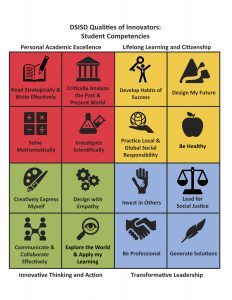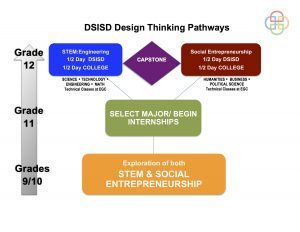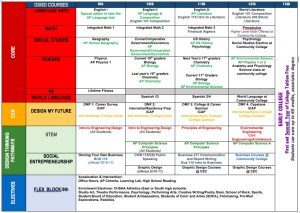Denver School of Innovation and Sustainable Design (DSISD): Competency-Based by Design
CompetencyWorks Blog
This post is part of an ongoing series on Colorado schools. Read about D51 and Westminster Public Schools for more insights.
Few public-school leaders outside of the charter sector have the opportunity to design their school from the ground up. In 2013, Danny Medved was invited by Denver Public Schools (DPS) to do just that. With support from the Carnegie Corporation of New York’s Opportunity by Design Challenge, Medved worked alongside staff from DPS’ Imaginarium to design a new, competency-based high school in Denver. This type of “in-house innovation” is unique within large urban school districts, and it provided an opportunity to draw upon the district resources and expertise while still enjoying the benefits of school autonomy and a fresh start.
 Mr. Medved looked directly to iNACOL’s 2011 working definition of competency-based learning to design the school. As any good innovator would, Mr. Medved borrowed from and built upon existing innovations and the experiences of others. As he explains, “we did not want to create from scratch what already exists but did want to use them in a way so as to have an individual school identity.” Other resources that directly informed the school design included Summit Public School’s Base Camp and Tony Wagner’s discussion of Play, Passion and Purpose. The ability to build upon the efforts of early innovators enabled the school to focus its creative energies upon the core beliefs and purposes of the school, and select the tools and resources that supported them. Core elements of the school’s competency-based model that ultimately emerged include:
Mr. Medved looked directly to iNACOL’s 2011 working definition of competency-based learning to design the school. As any good innovator would, Mr. Medved borrowed from and built upon existing innovations and the experiences of others. As he explains, “we did not want to create from scratch what already exists but did want to use them in a way so as to have an individual school identity.” Other resources that directly informed the school design included Summit Public School’s Base Camp and Tony Wagner’s discussion of Play, Passion and Purpose. The ability to build upon the efforts of early innovators enabled the school to focus its creative energies upon the core beliefs and purposes of the school, and select the tools and resources that supported them. Core elements of the school’s competency-based model that ultimately emerged include:
- School structure organized around iNACOL’s working definition of competency-based learning
- Academic and socio-emotional competencies aligned with DSISD’s four Qualities of an Innovator domains (Personal Academic Excellence Domain developed by Summit Public Schools)
- Instruction organized into six-week blocks, each focused upon a set of “power standards”; curriculum scope and sequence spirals throughout the year so that skills can be re-taught in the context of the next six-week sequence
- Personalized learning platform from Summit Public Schools
- Use cross-content standards to develop Student-Learning Objectives
- Deliver instruction using something similar to a rotational model that is differentiated using the modalities of minimal direct instruction, small group direct instruction, collaborative group work, and asynchronous learning time, with an emphasis upon project-based learning experiences embedded throughout the academic year and used to deliver cross-disciplinary content
- FLEX block included in students’ weekly schedule that allows for both acceleration and remediation opportunities as well as elective classes, such as art
- Clear set of teacher competencies; explains Mr. Medved “you can grow people to teach in this environment, but you need some rock star anchor teachers.”
With support from DPS, Mr. Medved was able to hire teacher leaders during the design process. Together, they completed the school planning process, including the build out of the school instructional plan. This distributed leadership model was an intentional part of the school design, which places an emphasis upon building the leadership capacity of other leaders within the school.
 After two years of focused planning, in 2015, the Denver School of Innovation and Sustainable Design (DSISD) welcomed its first students, a class of 100 ninth graders. Like any new school leader will tell you, you plan the school you envision, but the school isn’t established until the students arrive, testing the strength of a school design and forcing the school to determine what is fixed and what might need to change in response to what students and families bring with them to the school community. That first year was a learning experience for DSISD as much for the school’s faculty as for the students. A summary of lessons learned during that first year have been previously captured in a report by Denver Public School’s imaginarium, and you can read about them here: Personalized Learning: A Journey Through Year One (2016). However, a few lessons are worth calling out here with regard to the implementation of DSISD’s competency-based model. Some of these were identified by students and faculty at the school and others are offered by the author.
After two years of focused planning, in 2015, the Denver School of Innovation and Sustainable Design (DSISD) welcomed its first students, a class of 100 ninth graders. Like any new school leader will tell you, you plan the school you envision, but the school isn’t established until the students arrive, testing the strength of a school design and forcing the school to determine what is fixed and what might need to change in response to what students and families bring with them to the school community. That first year was a learning experience for DSISD as much for the school’s faculty as for the students. A summary of lessons learned during that first year have been previously captured in a report by Denver Public School’s imaginarium, and you can read about them here: Personalized Learning: A Journey Through Year One (2016). However, a few lessons are worth calling out here with regard to the implementation of DSISD’s competency-based model. Some of these were identified by students and faculty at the school and others are offered by the author.
Effectively communicating what the school is about is critical to identifying and attracting students who are excited about the school model. Communicating what DSISD’s model was and what would be different for students is hard to summarize in soundbites or to compare to other options available in the district. As a result, some students chose DSISD for reasons outside of the school’s vision or design. The reasons that students selected DSISD varied. Some students were drawn by the flexible learning environment and the hope for more personalized learning pathways. Others were focused upon smaller class sizes and the opportunity for a fresh start. Approximately 25 percent of DSISD’s first class arrived with Individual Education Plans, almost twice the district average. DSISD was ready to serve every student that arrived, however student needs and teacher and student input prompted some shifts in the program. For example, several students that first year determined that DSISD was not for them, opting instead to return to a more traditional school. Most of these students later returned, drawn back by the ability to exercise individual choice and design their own pathway, among other reasons. While describing something completely different than the traditional school model remains a challenge, DSISD continue to refine its message. Over time as the school grows to full enrollment and eventually has alumni, students will become the best ambassadors for the school. In the meantime, here are some resources that offer additional detail about how DSISD communicates its school model:
- A Day in the Life of a DSISD Student
- Danny Medved featured in iNACOL Webinar: Communication and Outreach Strategies for Leaders Shifting to Personalized Learning (April 2017)
Achieving equity requires more than access. Equity is a core goal at DSISD. It is evidenced most significantly in the leadership opportunities that are created and encouraged for students and faculty alike. Everyone has a voice and everyone’s voice matters. Academic courses were designed to provide universal access to rigorous content and multiple pathways to entry. Student Competencies focus upon non-academic skills as much as they do upon academic excellence. All students are provided “high value learning opportunities,” those designed to lead ultimately to college or well-paid careers. Despite this focus, a story from year 2 revealed that realizing equitable outcomes in academics requires more than universal access and expectations. All ninth graders participate in a Computer Science course as part of the “Design Thinking Pathways.” However, the following year only one girl elected to continue Computer Science. Rather than simply accept the student choice, school administration and faculty used it as an opportunity to reflect on why girls weren’t electing this pathway and how could it be made more accessible and engaging for female students. This response reflects the commitment to equity and continuous improvement that the school values.

Student agency requires schools to respond in new ways and is critical to a quality competency-based system. The school’s vision statement includes these phrases – “Empower all students to own their learning (Student Driven, Proactive and Passionate Approach to Learning)…and create a better world (Practice Local and Global Responsibility, Explore the World and Apply My Learning, Invest in Others and Lead for Social Justice)”. This is an inspiring vision for students’ future but can be hard to practice in a meaningful way within a school. DSISD seeks to provide students the opportunity to have voice and participate in the leadership of the school. School administrators provide formal (i.e., student council) as well as informal opportunities for students to voice their concerns. They also are expected to support their concerns with evidence and present a solution. At multiple points in the school’s first few years, students identified areas of the school program that they felt were not serving them. These included a variety of aspects from school dress code to dissatisfaction of the learning experiences which relied upon technology to enable students to progress through self-paced play lists. In the examples provided, the students met the expectations for self-advocacy and the school administration made the requested adjustments. While dress code changes may be straightforward to change, doing so requires school leadership to examine deeply what values matter to the school, and which ones are shared. Changes to instructional formats required real and at times difficult changes to staffing assignments and classroom experience. However, DSISD leadership understood that taking student’s concerns seriously would reap benefits for them as self-directed learners that extend well beyond their high school career.
“When you bring data driven instruction and project based learning, they don’t fit well together, no matter what anyone tells you,” observes Mr. Medved. Fostering student engagement and motivation requires the school to offer learning opportunities that are cross-disciplinary, relevant to their lives and require collaboration. DSISD frequently uses project based learning and other inquiry based models of instruction to engage students in deeper learning. However, these formats often make it hard to track individual student work, for example, or produce data that teachers can use to assess and diagnose individual student progress on a daily basis. Rather than abandon one or the other (project based learning or effective data driven instruction), the school continues to refine its formative and summative assessment practices and embed them in its project based learning opportunities.
Preparing students to be ready for college, career and life. Walk into just about any high school today and you will hear school administrators and faculty talk about their focus upon “college and career readiness”. This is also true at DSISD. However, DSISD has done a few things to prepare students for life after high school that are notable. Each year students participate in a “Design My Future” class that engage students in a sequence of activities that build upon each other and help them set a course for their lives. Students start with planning and exploration activities in ninth grade, as well as intentional learning activities designed to build competencies in Innovative Thinking and Action, Lifelong Learning and Citizenship, and Transformative Leadership. Job shadows and college visits start in ninth grade. At the end of tenth grade, students can elect to participate in an early college/internship model designed to provide them with apprenticeships and an Associate’s degree by the time they graduate high school. Through a unique program, supported by a grant from the US Department of Labor and a partnership with CareerWise Colorado, DSISD students participate in Denver Public Schools’ Career Connect. Rather than force students to choose between a “college path” or a “career path,” DSISD students start early on developing preparedness for both. Advanced Placement (AP®) courses are made available to all students, with intentional instructional strategies designed to support students for whom the academic content is new so that they can benefit from the exposure and rigor in a way that increases academic self-confidence. The results to date are impressive: 85 percent of ninth graders earned college credit; 100 percent of students visited at least two college campuses; 80 percent of students had career shadows; 95 percent were “on-track” to graduate. This would be impressive at any school but is unique at a school where over 60 percent of students are eligible for free and reduced price lunch.
Evidence of what DSISD is doing right surfaced this past spring when Mr. Medved, founding principal of the school, announced he would be leaving at the end of the year. Denver Public Schools takes seriously the task of hiring school leaders and promptly initiated its process, which culminates in the final decision being made by Superintendent Tom Boasberg. Students, accustomed to having a voice in key decisions, expected they would have a voice in selecting the new school leader as well. Without prompting from the school administration, students took up a petition to make their wishes known to the district leadership. As a result, students were given a voice not typical in the hiring of school leaders. The school’s vision of empowered students who create a better world was on full display.
 The second example of DSISD’s success was evidenced by who was ultimately selected to succeed Mr. Medved as school principal, Lisa Simms. Ms. Simms was a member of the founding leadership team and knows the school well. However, her selection was not simply reward for her tenure. Instead, her ability to step into the role reflects the distributed and empowered leadership model that the school has built. Indeed, building the leadership capacity of others on the team is an intentional part of DSISD’s innovation plan. In the case of Ms. Simms, her succession was a natural next step for the school. As one of the original school designers and a teacher during year 1, she played a key role in the build-out of the school design and in hiring staff. She initially joined the school leadership team with a plan to move into the Assistant Principal role when the school was approved in November 2014. The scaling of her role was tiered, moving from teacher leader in the school’s first year (2015-16) before moving into the Assistant Principal role in 2016-17. Although sooner than anyone had initially planned for, when the opportunity for stepping up was presented, Ms. Simms was ready for the challenge. No doubt, Ms. Simms will face new challenges and bring new strengths to the role as the new principal. However, the school’s early years are a promising start to a high-quality competency-based school serving a diverse group of students in a large, urban district.
The second example of DSISD’s success was evidenced by who was ultimately selected to succeed Mr. Medved as school principal, Lisa Simms. Ms. Simms was a member of the founding leadership team and knows the school well. However, her selection was not simply reward for her tenure. Instead, her ability to step into the role reflects the distributed and empowered leadership model that the school has built. Indeed, building the leadership capacity of others on the team is an intentional part of DSISD’s innovation plan. In the case of Ms. Simms, her succession was a natural next step for the school. As one of the original school designers and a teacher during year 1, she played a key role in the build-out of the school design and in hiring staff. She initially joined the school leadership team with a plan to move into the Assistant Principal role when the school was approved in November 2014. The scaling of her role was tiered, moving from teacher leader in the school’s first year (2015-16) before moving into the Assistant Principal role in 2016-17. Although sooner than anyone had initially planned for, when the opportunity for stepping up was presented, Ms. Simms was ready for the challenge. No doubt, Ms. Simms will face new challenges and bring new strengths to the role as the new principal. However, the school’s early years are a promising start to a high-quality competency-based school serving a diverse group of students in a large, urban district.
You can read more about the Denver School of Innovation and Sustainable Design here:
- Personalized Learning: A Journey Through Year One (Denver Public Schools imaginarium, 2016).
- Iteration in Action (by Springpoint Schools, February 18, 2017)
- Innovative Urban Education in Denver
- Student-Centered Design at the Denver School of Innovation and Sustainable Design (SpringPoint, April 2017)
Note: Carnegie Corporation of New York provides financial support to CompetencyWorks and also to DSISD.
Nina Lopez is an independent consultant, based in Boulder, CO. Nina provides facilitation, strategy and innovation design services to private foundations, non-profit and government entities in Colorado and throughout the country to help them incubate new initiatives, develop a shared vision and a clear strategy for achieving individual and collective goals. www.ninalopez.com


